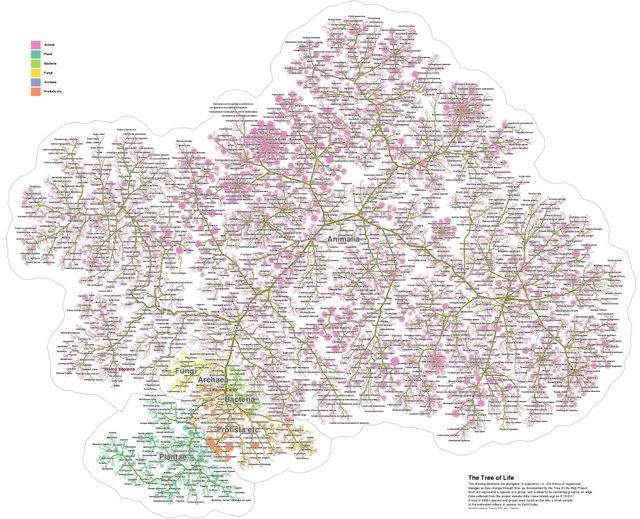You are viewing a single comment's thread from:
RE: The Myth Of Evolution
The reason why we are running out of antibiotics is due to both the, in human terms, extremely rapid and vast generation of, well.. new generations. If we then try to kill them off, we further help the evolution of bacteria resistant to antibiotics. This makes the bacteria stronger in its current habitat, not weaker / degenerate. Exactly like all other form of evolution. Intentional cross-breeding and then inter-breeding of specific traits is not how stable life-forms are created, which is probably where you have gotten the idea of errors. Not to mention the everyday use of "genetic mutation" coupled with diseases.
Dear @jwamshop,
The reason certain strains of bacteria become resistant to antibiotics is not caused by their evolving resistant traits through positive mutation. They have lost the ability to absorb the antibiotic. In any case, they have not evolved into a different microbe, they still are bacteria. this is not a case for evolution but variation within a species that keeps the life form from extinction.
Thanks for the reply, @lastdays. When you say that "they have lost the ability to absorb the antibiotic" rather than it being caused by resistant traits, wherein are you saying this capability of resisting it lies, and how did it came to be?
Claiming "Variation within a species" is a bit of a fallacy, as the definition and classification of species is done by us. Humans are not dogs. But we are of the category "great apes", as well as the category of "mammals". Dogs are also part of this category, just a different branch.
This does not mean that Dogs are Human, or that "Human can evolve into dogs". It only means we have common ancestor. If we had decided to call what we call "Mammals" "species" instead, then yes, we would still be of the same species.
You already know that we have done extensive research on this in many different fields of science. Biochemistry (DNA), Archaeology, Zoology, Medicine, Chemistry (like carbon dating), all point at the same conclusion. As a result, we are able to illustrate the tree of life extensively, including species that are long gone.
As an example, see this fantastic image (courtesy of "The Tree of Life Web project")

(Don't forget to zoom in on it! It's amazing)
Externalists (evolutionists) see the environment as the subject acting on an organism as an object. They view organisms as modeling clay squeezed by the hands of the environment over time via “selective pressures” that are external to, and imposed on, organisms. Additionally, they consider that “the environment directly instructs the organism how to vary” during adaptation. Believing that nature’s selection process operates in a way similar to human volition, externalists see nature as exercising an agency that enables it to see, select, save, and build organisms. Thus, nature is the cause of life’s diversity. Those trained in biology view living things through the lens of Darwin’s bold counter-perception of organisms as the objects of environmental actions.
This is a natural conclusion from the notion that nature exercises selective agency to mold living things. Causality is linked to credit—or blame—for why something exists or happens. Darwin was very knowledgeable of biological-design theory and recognized this. But Darwin’s approach is not a necessity of scientific methodology and is only the expression of his naturalistic worldview. Even though his externalism projects mystical powers onto nature and invokes such expansive imagination where pots make potters and nature crafts designers, externalists must adhere to it, as Harvard geneticist Richard Lewontin candidly says, “no matter how counter-intuitive, no matter how mystifying to the uninitiated” because of their rigid commitment to naturalism.
Yet another approach sensibly uses engineering principles to explain biological systems that fit patterns of design—no initiation is required. Organisms wouldn’t be viewed as passive modeling clay but seen as having engineered innate adaptability that enables them to be active, problem-solving entities. Discoveries of diverse internal mechanisms foster another new concept: Adaptation is based on a compilation of engineered systems that enable rapid growth and physiological changes to environmental cues and challenges.
A design-based, organism-focused model could posit that as organisms actively travel through space-time, they continuously track environmental conditions, and their inherent capabilities express suitable traits. These features are the outworking of systems with intrinsic sensors and programmed logic that are accurately described with engineering causality—which is characterized as internal to them.
When causality is objectively determined by an approach like engineers use—one that identifies all biological elements in a process and omits mystical events—the observed elements of a self-adjusting process confirm internalism and conflict with externalism. Thus, an organism’s surveillance systems seem to actively acquire data that they process into information; they aren’t “sent instructions” by the environment. Their internal programming specifies what condition will be a stimulus or a signal. An integrated sensor for that condition is the vital trigger of their response. Many responses appear to be highly targeted to specific conditions, not the hit-and-miss solutions conjectured by selectionism. Finally, these mechanisms don’t appear to be randomly implemented but are highly regulated and characterized as rapid, repeatable, and sometimes reversible.
Using engineering principles , it isn't the environmental pressures that cause genetic changes over long periods of time to develop the ability for an animal to adapt (evolutionary theory). God designed each type of animal (felines, bovines, canines, etc.) with the capacity to perceive changes and activate or shut down certain genes which already existed resulting in adaptation.